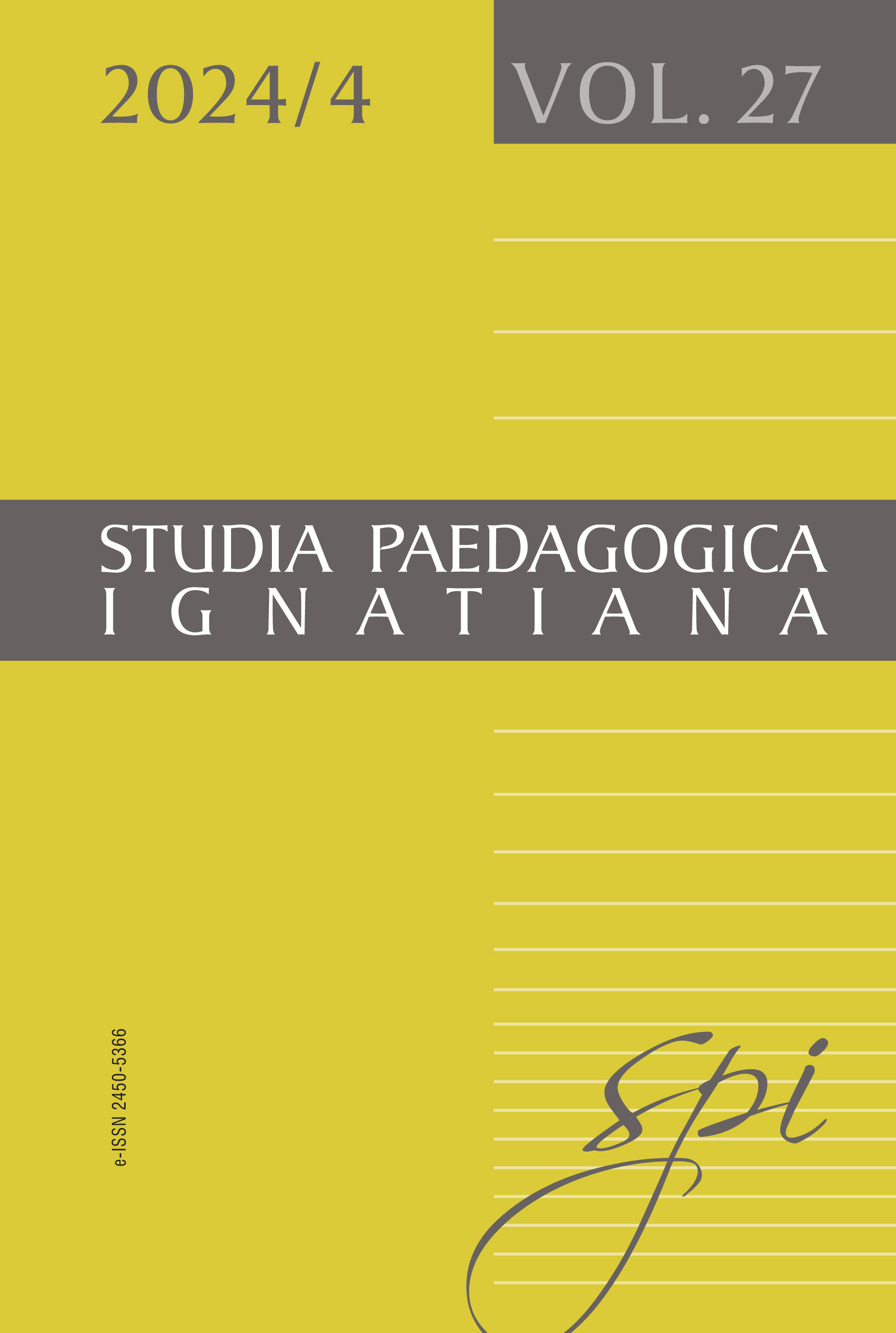Achieving Well-being in a Digital World in the Context of Children and Young People’s Needs: Individual and Social Dimensions of the Issue
DOI:
https://doi.org/10.12775/SPI.2024.4.009Keywords
digital well-being, children, youth, digital skills, online opportunities, online risksAbstract
The goal of this article is to show the multidimensional nature of digital well-being, in both individual and social dimensions. It describes the components that contribute to overall quality of life in the digital sphere from the point of view of young digital media users, with a particular focus on the informational and communicative aspects. The text scrutinizes the diversity of theoretical and practical approaches, as well as details the capacities and conditions that are required today to maintain a balance in the use of new technologies. These include navigating the digital media space efficiently and safely, mitigating potential risks, and capitalizing on its opportunities.
The supportive roles of parents and teachers in helping the younger generation achieve well-being in the digital media world are also discussed. The article presents and analyzes recent research findings that reveal the extent of children and young people’s immersion in digital spaces and the emerging trends associated with this phenomenon. Additionally, it points out current patterns and transformations in media use that have an impact on the overall individual well-being.
References
2030 Digital Compass – The European Way for the Digital Decade, European Commission, Directorate-General for Communications Networks, Content and Technology, Publications Office of the European Union (2021), https://data.europa.eu/doi/10.2759/425691 [dostęp: 23.07.2024].
Achremowicz H., Litwin P., Meyza I., Monkos A., Smolińska P., Węgrzyn R., Zakrzewski P. (2024). Od emocji do odporności na dezinformację. Scenariusze zajęć dla dzieci i młodzieży, Warszawa: Fundacja Szkoła z klasą. DEMAGOG, https://www.szkolazklasa.org.pl/wp-content/uploads/2024/03/od-emocji-do-odpornosci-na-dezinformacje-scenariusze-zajec-dla-dzieci-i-mlodziezy.pdf [dostęp: 23.07.2024].
Büchi M. (2024). Digital Well-being Theory and Research, „New Media & Society”, t. 26, nr 1, s. 172–189, https://doi.org/10.1177/14614448211056851
Children’s Media Lives 2024. Ten Years of Longitudinal Research: A Report for Ofcom (2024), https://www.ofcom.org.uk/siteassets/resources/documents/research-and-data/media-literacy-research/children/children-media-use-and-attitudes-2024/childrens-media-lives-2024-summary-report.pdf [dostęp: 23.07.2024].
Cyberprofilaktyka NASK, https://cyberprofilaktyka.pl/cyberprofilaktyka-nask-o-nas/projekty.html [dostęp: 12.07.2024].
Dębski M., Bigaj M. (2019). Młodzi Cyfrowi. Nowe technologie. Relacje. Dobrostan, Gdynia: Gdańskie Wydawnictwo Psychologiczne.
Dobrostan cyfrowy. Poradnik dla rodzin (2020), https://www.szkolazklasa.org.pl/materialy/asy-internetu-dobrostan-cyfrowy-poradnik-dla-rodzin/ [dostęp: 23.07.2024].
Kardefelt-Winther D., Saeed M., Al-Harahsheh S.T., Saxena S., Aref A., Al-Kahlout D., Al-Mohannadi A.S. (2022). Child Well-being in a Digital Age: Trends and Outcomes. WISH, https://www.researchgate.net/publication/359897131_Child_Well-Being_in_a_Digital_Age_Trends_and_Outcomes [dostęp: 23.07.2024].
Levine D., Page A., Law E., O’Reilly M. (2021). Children and Families’ Wellbeing in a Digital World: A Four-dimensional Model. University of Leicester, https://www.internetmatters.org/pl/about-us/children-and-families-wellbeing-in-a-digital-world-report/ [dostęp: 23.07.2024].
Livingstone S., Mascheroni G., Stoilova M. (2021). The Outcomes of Gaining Digital Skills for Young People’s Lives and Wellbeing: A Systematic Evidence Review, „New Media & Society”, t. 25, nr 5, s. 1176–1202, https://doi.org/10.1177/14614448211043189
NASK (2023). Nastolatki 3.0. Raport z ogólnopolskiego badania uczniów i rodziców, Warszawa: NASK, Państwowy Instytut Badawczy, https://www.nask.pl/pl/aktualnosci/5316,Co-robia-nasze-dzieci-w-sieci-czyli-Raport-z-najnowszego-badania-NASK-Nastolatki.html [dostęp: 30.09.2024].
OECD (2019). How’s Life in the Digital Age?: Opportunities and Risks of the Digital Transformation for People’s Well-being, Paris: OECD Publishing, https://doi.org/10.1787/9789264311800-en
Ptaszek G., Dębski M., Bigaj M., Stunża G., Pyżalski J. (2020). Zdalna edukacja – gdzie byliśmy, dokąd idziemy? Wstępne wyniki badania naukowego „Zdalne nauczanie a adaptacja do warunków społecznych w czasie epidemii koronawirusa”, Warszawa.
Pyżalski J., Zdrodowska A., Tomczyk Ł., Abramczuk K. (2019). Polskie badania EU Kids Online 2018. Najważniejsze wyniki i wnioski, Poznań: Wydawnictwo Naukowe UAM, https://press.amu.edu.pl/pub/media/productattach/p/y/pyzalski_polskie_badanie_eu_kids_online_2018_amup.pdf [dostęp: 23.07.2024].
Rada Unii Europejskiej (2022). Konkluzje Rady w sprawie wspierania dobrostanu w edukacji cyfrowej (2022/C 469/04), https://eur-lex.europa.eu/legal-content/PL/TXT/PDF/?uri=CELEX:52022XG1209(01) [dostęp: 23.07.2024].
Smahel D., Machackova H., Mascheroni G., Dedkova L., Staksrud E., Ólafsson K., Livingstone S., Hasebrink U. (2020). EU Kids Online 2020: Survey Results from 19 Countries. EU Kids Online, https://kometa.edu.pl/biblioteka-cyfrowa/publikacja,908,eu-kids-online-2020-survey-results-from-19-countries [dostęp: 23.07.2024].
Twenge J.M. (2019). iGen. Dlaczego dzieciaki dorastające w sieci są mniej zbuntowane, bardziej tolerancyjne, mniej szczęśliwe – i zupełnie nieprzygotowane do dorosłości, przeł. O. Dziedzic, Sopot: Smak Słowa.
Vanden Abeele M.M.P. (2021). Digital Wellbeing as a Dynamic Construct, „Communication Theory”, t. 31, nr 4, s. 932–955, https://doi.org/10.1093/ct/qtaa024
Vuorikari R., Kluzer S., Punie Y. (2022). DigComp 2.2: The Digital Competence Framework for Citizens – With New Examples of Knowledge, Skills and Attitudes, Luxembourg: Publications Office of the European Union, https://publications.jrc.ec.europa.eu/repository/handle/JRC128415 [dostęp: 23.07.2024].
Well-being in the Digital Age (2023). Luxembourg: Publications Office of the European Union, https://nesetweb.eu/wp-content/uploads/2023/12/well-being-in-the-digital-age-NC0723199ENN-2.pdf [dostęp: 23.07.2024].
Wielki słownik języka polskiego (2024), https://wsjp.pl/ [dostęp: 23.07.2024].
Downloads
Published
How to Cite
Issue
Section
License
Copyright (c) 2024 Irena Pulak

This work is licensed under a Creative Commons Attribution-NoDerivatives 4.0 International License.
By submitting an article, the author declares that:
they are the author of the article (hereinafter referred to as the Work) and:
- is entitled to exclusive and unlimited copyright to the Work,
- is entitled to dispose of the copyrights to the Work.
The Author grants the Jesuit University Ignatianum in Cracow a free, non-exclusive, territorially unlimited license to use the Work in the following fields of exploitation:
- publishing the Work in paper, digital or magnetic form;
- multiplying the work by any method, without limiting the number of editions or copies;
- distribution of the work and its copies in any form, including marketing, sales, lending, and lease;
- placing the work in a computer memory;
- distribution of the work in information networks, including the Internet;
- public performance, exhibition, display, reproduction, broadcasting and re-broadcasting, as well as making the Work available to the public in such a manner that everyone could have access to it at a time and place chosen by themselves;
- within the scope of dependent rights to the Work, covering, in particular, the right to make necessary changes to the Work, resulting from editorial and methodical preparation, as well as to make translations of the Work into other languages.
The license right shall be transferred the moment of transfer of the Work to the Jesuit University Ignatianum in Cracow. The Jesuit University Ignatianum in Cracow is entitled to grant sub-licenses to the Work in terms of the right granted. The license shall be limited in time for a period of 15 years from the date it is granted.
Stats
Number of views and downloads: 484
Number of citations: 0



